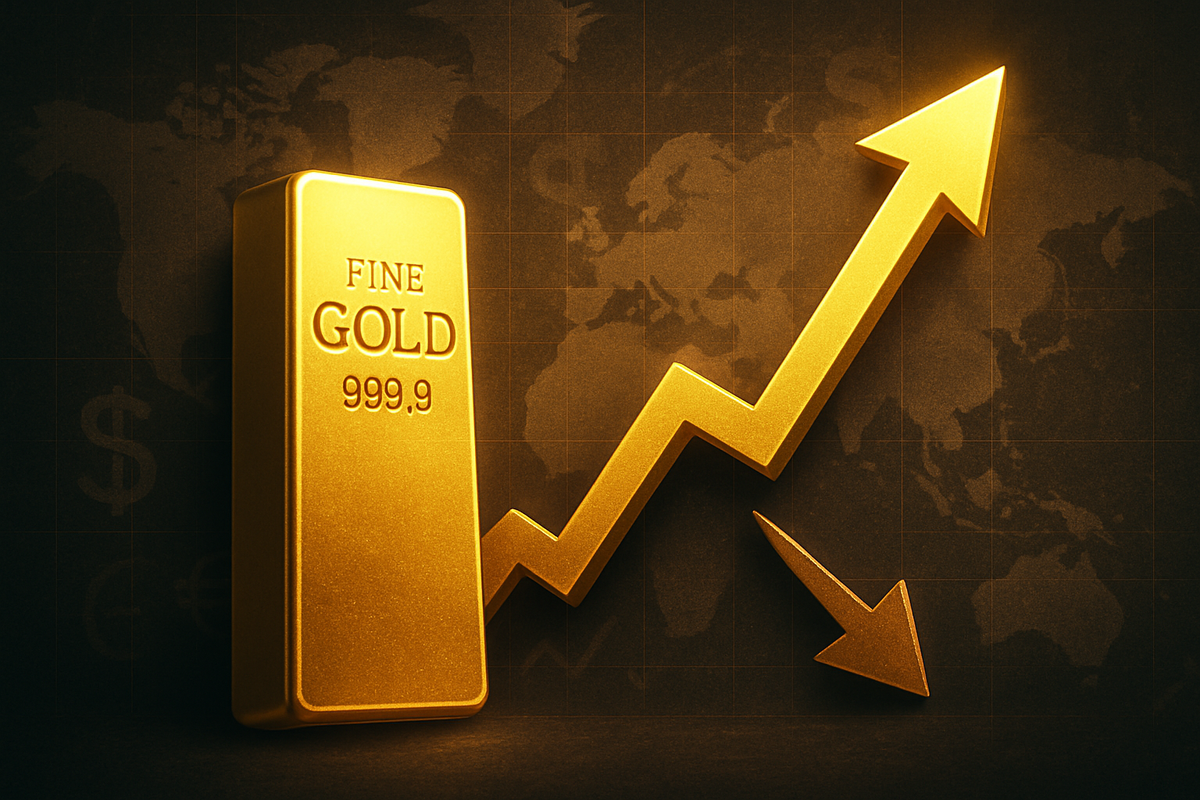
September 2025 has delivered a paradoxical performance for gold investors, as the precious metal navigated a landscape of unprecedented highs and subsequent pullbacks. While bullion retreated from a fresh all-time record peak in the final days of the month due to significant profit-taking, it simultaneously concluded September poised for its most robust monthly gain in a remarkable 14 years. This intriguing dichotomy highlights the complex interplay of speculative fervor, fundamental drivers, and market psychology currently shaping the gold market, leaving investors to weigh the implications of short-term corrections against a powerful underlying bullish trend.
The yellow metal's rollercoaster ride underscores a period of intense market activity, driven by a confluence of global uncertainties and shifting monetary policy expectations. Despite ending the month with a sharp decline from its apex, gold's overall September surge, ranging between 11.4% and 12%, represents a formidable demonstration of its enduring appeal as a safe-haven asset and an inflation hedge. This contrasting narrative of retreat from a record while securing a historic monthly performance sets the stage for a compelling analysis of gold's trajectory in the months ahead.
A Month of Milestones and Market Corrections
September 2025 will be etched in the annals of gold market history as a month of extraordinary highs and strategic retreats. Throughout the month, spot gold prices relentlessly pushed into uncharted territory, culminating in an all-time high of approximately $3,842.76 per ounce on September 30, with December gold futures even touching $3,895.22 per ounce. This sustained rally was fueled by a potent mix of macro-economic and geopolitical factors that collectively bolstered gold's appeal.
The timeline of events leading to this moment was swift and impactful. Early September saw gold already testing significant psychological barriers, retreating briefly from $3,578.50 on September 1 to around $3,470 on September 2, as an initial wave of profit-taking emerged alongside a strengthening U.S. dollar. However, this proved to be a minor blip in a larger upward trend. Fears of a potential U.S. government shutdown, coupled with growing expectations of further interest rate cuts by the Federal Reserve, provided significant tailwinds. Traders were pricing in an approximate 89% chance of a 25-basis-point reduction at the upcoming October Fed meeting, making non-yielding gold increasingly attractive. Adding to the bullish sentiment were persistent global uncertainties, including ongoing geopolitical tensions in the Middle East, the Russia-Ukraine conflict, and renewed trade complications stemming from U.S. tariff discussions. A weakening U.S. dollar further amplified demand by making gold cheaper for international buyers, while persistent inflation concerns (August inflation at 2.9%) solidified gold's role as a hedge against rising prices. Crucially, significant central bank purchases, particularly from nations like China and Russia, and substantial inflows into gold-backed Exchange Traded Funds (ETFs) provided strong institutional support, with ETF holdings reaching their highest levels since July 2022.
However, as gold approached and breached successive record levels, the inevitable force of profit-taking began to exert its influence. On September 24, following comments from U.S. Federal Reserve Chair Jerome Powell emphasizing "no risk-free path" for monetary policy and cautioning against premature rate cuts, gold experienced a slight pullback from its elevated levels. The most significant retreat occurred on September 30, as gold prices dropped sharply from their record highs. This end-of-month correction was largely attributed to traders reassessing risk exposure and locking in profits after an impressive 11% to 12% gain since the beginning of the month. The onset of China's eight-day Golden Week holiday also played a role, as it typically reduces physical demand from a key consumer market, encouraging further profit-taking. Despite these late-month corrections, gold's overall performance in September, with gains exceeding 11%, marked its strongest monthly advance since August 2011, making it a 14-year high.
Corporate Fortunes Tied to Gold's Ascent
The dramatic surge and subsequent volatility in gold prices during September 2025 have significant implications for public companies operating within the precious metals sector, creating both substantial opportunities and potential challenges. Gold mining companies, in particular, are directly impacted by price fluctuations, with higher gold prices generally translating to increased revenues and improved profitability.
Major gold producers such as Barrick Gold (NYSE: GOLD) and Newmont (NYSE: NEM) stand to be significant beneficiaries of the recent rally. A sustained period of elevated gold prices enhances their profit margins, allows for increased capital expenditure in exploration and development, and can lead to improved shareholder returns through dividends or buybacks. During September's ascent, these companies likely saw their stock prices appreciate, reflecting the market's anticipation of stronger financial performance. However, the late-month profit-taking and subsequent price retreat, while not erasing the monthly gains, introduce an element of volatility that can affect short-term trading strategies and investor sentiment. Mining companies with higher operational costs or those heavily leveraged might experience more pronounced swings in their valuations. Beyond the direct miners, companies involved in gold exploration, refining, and specialized equipment manufacturing for the mining industry also benefit from a buoyant gold market, as increased investment flows through the entire supply chain.
Conversely, while the overall trend for gold was positive, the profit-taking episodes could impact companies that had hedged their production at lower prices, potentially limiting their upside. Furthermore, industries that use gold as a raw material, such as luxury jewelry manufacturers or electronics companies, might face increased input costs, which could squeeze their margins if they are unable to pass these costs onto consumers. For example, Tiffany & Co. (NYSE: TIF) (though now owned by LVMH) or other high-end jewelers might see some pressure on their cost of goods sold, although the prestige nature of their products often allows for price adjustments. Exchange Traded Funds (ETFs) that track gold prices, such as the SPDR Gold Shares (NYSE Arca: GLD), saw substantial inflows throughout September, indicating robust investor interest. However, the late-month dip could trigger minor outflows or dampen enthusiasm temporarily, although the overall strong monthly performance is likely to keep these funds attractive for investors seeking gold exposure.
Wider Significance: A Barometer of Global Uncertainty and Shifting Dynamics
Gold's extraordinary performance in September 2025 transcends mere price movements; it serves as a potent barometer of deeper global economic anxieties and shifting financial paradigms. The metal's surge, even amidst profit-taking, underscores its enduring role as a premier safe-haven asset, reflecting widespread investor concern over inflation, geopolitical instability, and the future trajectory of monetary policy. This event fits squarely into a broader trend of de-dollarization and a global flight to quality, signaling a fundamental shift in how investors and central banks perceive risk and value.
The ripple effects of gold's robust rally are far-reaching. Other precious metals, notably silver, often move in tandem with gold, and September likely saw parallel strength in these markets. Higher gold prices also invigorate the entire mining sector, from exploration companies to refiners, potentially leading to increased investment, production, and job creation. Conversely, the enhanced appeal of gold can draw capital away from riskier assets like certain equities and bonds, creating a negative correlation that offers diversification benefits for some portfolios, though some studies suggest gold's correlation with stocks has occasionally turned positive during recent crises. Central banks, particularly those in emerging economies, have been consistently increasing their gold reserves, a trend reinforced by gold's September performance. This strategic accumulation is driven by a desire to diversify away from the U.S. dollar, hedge against currency volatility, and strengthen national currencies, indicating a long-term rebalancing of global reserve assets. In fact, gold now holds a larger share of central bank reserves than Treasuries for the first time since 1996, becoming the second-largest global reserve asset after the U.S. dollar.
From a regulatory and policy standpoint, significant gold price movements can prompt various responses. Central bank monetary policies, particularly interest rate decisions, are intrinsically linked to gold's attractiveness; lower rates reduce the opportunity cost of holding non-yielding gold. Governments might also grapple with issues like gold smuggling, which can be exacerbated by high prices, leading to strengthened industry regulations, traceability systems, and efforts to formalize the gold sector. Trade policies, such as a hypothetical 39% tariff imposed by the U.S. on Swiss gold imports (as discussed in early 2025 research), can disrupt established industry structures and shift trading patterns, encouraging geographic diversification of refining capacity. Historically, gold rallies often coincide with periods of high inflation and geopolitical upheaval, much like the 1970s bull market or the post-2008 financial crisis era. The current environment, characterized by persistent inflation concerns (August inflation at 2.9%), geopolitical tensions in various regions, and the specter of a U.S. government shutdown, draws strong parallels to these historical precedents, reinforcing gold's role as a hedge against systemic risks.
What Comes Next: Navigating Gold's Future Trajectory
The compelling performance of gold in September 2025, marked by both record highs and strategic profit-taking, sets the stage for a fascinating period ahead. In the short term, the market may experience continued volatility as investors digest the recent surge and re-evaluate their positions. The immediate aftermath of the month-end profit-taking could see some further consolidation or minor corrections. However, the underlying bullish drivers – including persistent geopolitical tensions, ongoing inflation concerns, and expectations of Federal Reserve interest rate cuts – are likely to provide a strong floor for prices. Traders will be closely watching for any new developments regarding U.S. government funding, the Fed's rhetoric on monetary policy, and shifts in global risk sentiment.
Looking further out, the long-term outlook for gold appears robust, provided the fundamental conditions that fueled September's rally persist. Potential strategic pivots for investors might involve maintaining a diversified portfolio with a strategic allocation to gold as a hedge against broader market instability and inflation. Should the U.S. dollar weaken further, or if global central banks continue their aggressive gold accumulation, these factors could propel gold to new highs. Market opportunities may emerge for nimble investors during periods of profit-taking, allowing for strategic entry points. Conversely, challenges could arise if inflation moderates more rapidly than expected or if central banks signal a more hawkish stance on interest rates, increasing the opportunity cost of holding gold. Potential scenarios range from a sustained upward trajectory, with gold consolidating its gains and gradually climbing higher, to periods of choppy trading as conflicting economic signals emerge.
Key factors that will dictate gold's path include the Federal Reserve's actual interest rate decisions and forward guidance, which could either bolster or temper gold's appeal. Economic data, particularly inflation reports and employment figures, will also be critical in shaping market expectations. Geopolitical developments, especially in volatile regions, will continue to drive safe-haven demand. Investors should also monitor central bank gold purchasing trends and the flow of funds into gold-backed ETFs, as these institutional movements provide strong indicators of underlying demand. The interplay of these forces will determine whether gold can sustain its momentum and cement its position at these elevated levels or if it will face more significant headwinds in the coming months.
Comprehensive Wrap-Up: Gold's Enduring Allure in a Volatile World
September 2025 will be remembered as a pivotal month for gold, characterized by a remarkable surge to record peaks, punctuated by necessary profit-taking, yet culminating in its strongest monthly performance in 14 years. The key takeaway from this period is gold's undeniable resilience and its reinforced role as a critical asset in times of global uncertainty. The confluence of U.S. government shutdown fears, expectations of Fed rate cuts, persistent geopolitical tensions, and ongoing inflation concerns created a perfect storm for the yellow metal, driving its price to unprecedented levels. The late-month retreat, while significant in percentage terms for a single day, was largely a function of market participants locking in substantial gains and end-of-quarter rebalancing, rather than a fundamental shift in gold's underlying drivers.
Moving forward, the market will likely remain highly attentive to the same macro-economic and geopolitical indicators that propelled gold throughout September. The assessment of gold's trajectory suggests a continued bullish bias, albeit with potential for short-term corrections. Its status as a hedge against inflation and a safe haven during times of political and economic instability has been emphatically reaffirmed. The sustained demand from central banks further solidifies its long-term appeal, indicating a strategic shift in global asset allocation away from traditional fiat currencies.
In conclusion, gold's September performance underscores its lasting significance as a store of value and a critical component of diversified portfolios. Investors should watch closely for further cues from central bank policies, particularly the Federal Reserve's stance on interest rates, and monitor global geopolitical developments. Economic data, especially inflation metrics and employment reports, will also be crucial in gauging the market's risk appetite. While volatility is to be expected, the fundamental drivers that have propelled gold to its current elevated levels appear to be firmly in place, suggesting that the precious metal will continue to play a vital role in navigating the complexities of the modern financial landscape.
This content is intended for informational purposes only and is not financial advice






